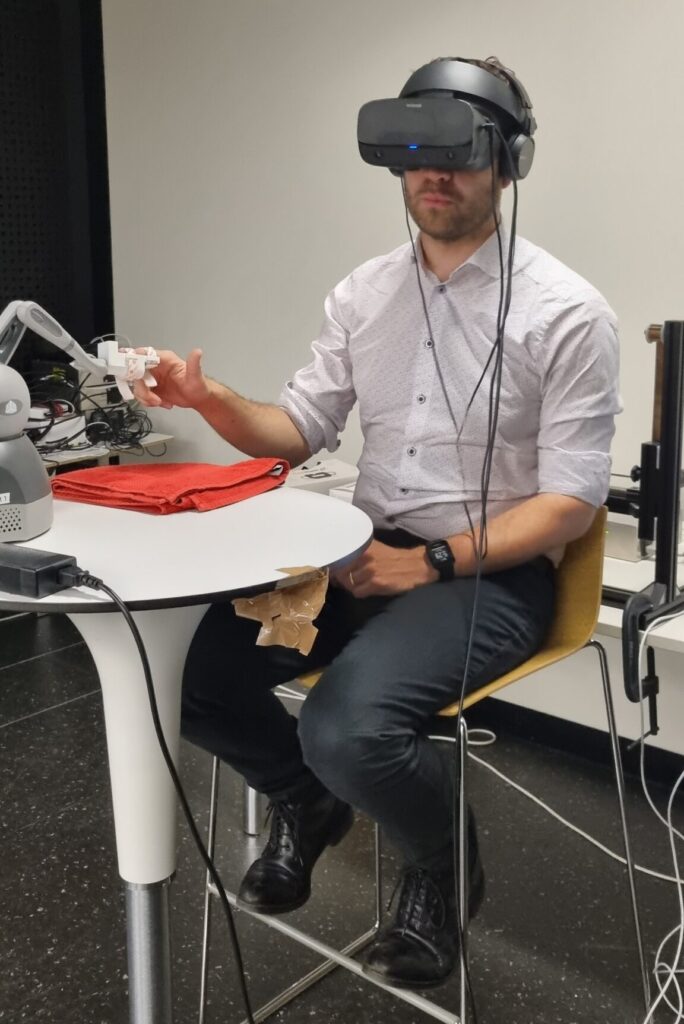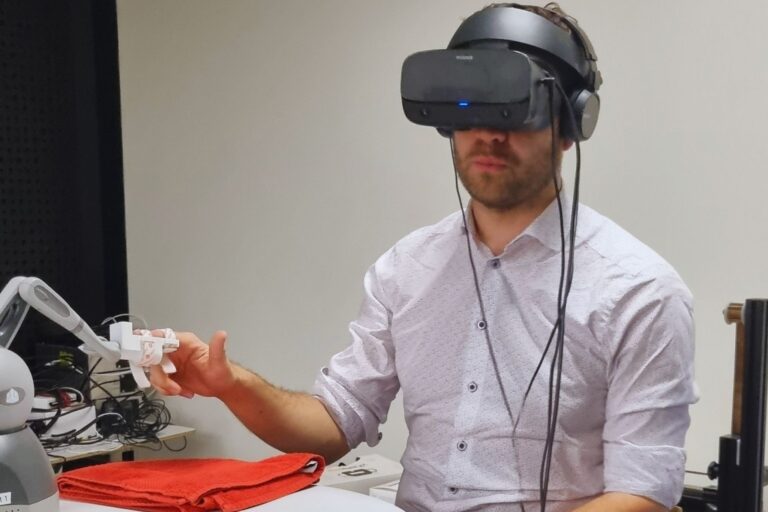Bonus clip from Presence: Hallucination or Visitation, with Dr. Ben Alderson-Day.
Narrator: Thank you for downloading this bonus clip from This Is Your Brain. In this excerpt, Dr. Ben Alderson-Day describes his recent visit to the lab of a fellow Presence researcher Dr. Olaf Banke in Geneva Switzerland, where he has able to elicit his own personal experience of a “presence” using virtual reality goggles and a robot which interrupts the sensory feedback loop.

Phil Stieg: So, Ben, tell me a little bit about the robot as it relates to presence.
Ben Alderson-Day: This is an experimental procedure devised by Olaf Blanke, a German neurologist and his team based in Geneva. It’s a robot which essentially depends on mucking up our expectations of our movements of our body.
Imagine you’re sitting on a seat, and you’re blindfolded, and you put your finger into a little handle thing here, and you’re seeking to just kind of press in front of you like this. And what that handle is doing is it’s rigged up to a system behind you where a robot is poking you in the back. Okay.
Now, what happens is, when this thing is happening in sync, which is its standard mode, sometimes people feel a bit weird. Sometimes they feel like they’re stroking their own back. This is something that we would expect from how the body and the motor system works. But after a while, what you can do is slow down the robot, so the touches become slightly out of sync. They start to drag. They’re not in the right place, and you start to feel unusual.
And what Blanke’s team found, was that for a subset of participants, they start to feel like somebody else is there in the room with them. They might describe it spontaneously. They might rate it as slightly more likely on kind of questionnaire scales.
They’ve even got very clever tests where they get you to very quickly estimate how many people are in the room. If the robot is out of sync, you’re feeling slightly unusual, you consistently estimate that an extra person is there in the room with you. Now, you might think, what the hell is going on here? This just sounds like a weird fairground setup, but essentially the principle is really correct behind it.
We expect our senses to sync up together in time when we move our bodies. When I clap my hands, I expect the sound and the image to all go together at the same time. Now, imagine what would happen if you go to clap your hands and you hear the sound before you see your hands come together, before you feel them come together, you’d feel unusual. And what would you think? You’d think that somebody else had made the sound.
A lot of our agency judgments, our judgments about self versus other are about what happens when these things go in and out of sync. And that’s what the presence robot is doing, essentially. It’s invoking a feeling of the other by mucking up what we expect from our movements.
Now, as it happens, I had a go on the presence robot a couple of weeks ago. I went and visited this lab in Geneva, and I have to say, it was a really unusual experience for me. I’m not sure I got full presence, but then I’m not such a hallucinatory guy. But I definitely felt like there was somebody else in the room with me. And it was like having a really draggy dance partner. Like, come on, you haven’t listened to the instructions. We’re going to fail this test. It definitely felt like I was suddenly in a team with somebody else. It’s definitely an unusual thing to try.
Phil Stieg: How is that different than Pavlovian conditioning?
Ben Alderson-Day: Well, for something like conditioning, you need to have many trials in which you build up an association with between two different kinds of stimuli. Right. Or you need to have a very strong, say, enhancer of something to kind of band that together. But for something like the presence robot, you don’t necessarily need to build up a prior association. What it’s doing is essentially taking advantage of something built into our motor system.
We are used to our sensory cues all matching up at the same time. So you disrupt that, then any number of unusual things can happen.
Additional Resources



